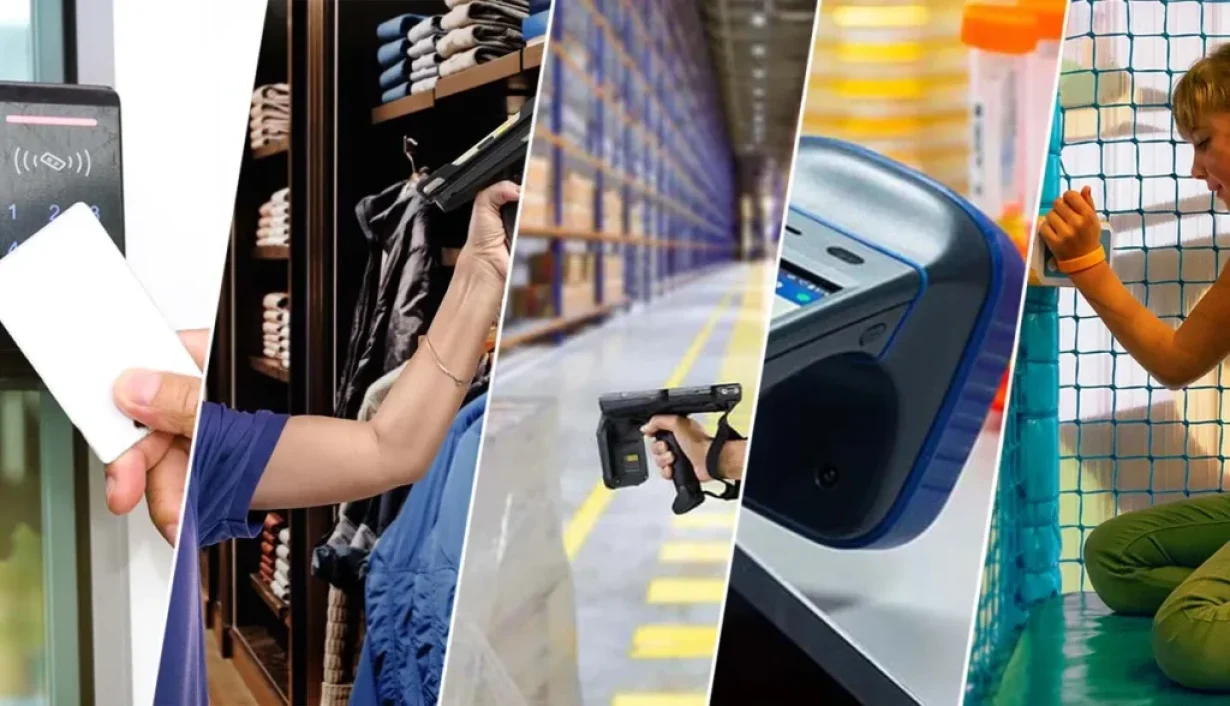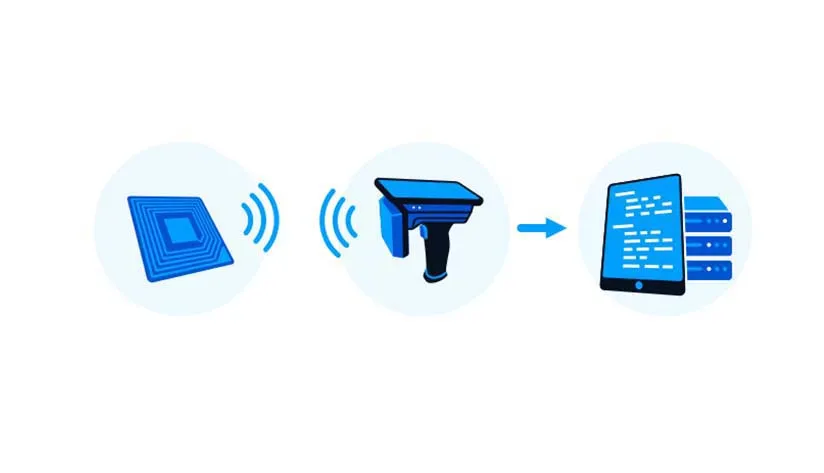
Transform Your Business with RFID Technology: Efficiency, Security, and ROI
In today’s fast-paced, data-driven world, businesses are constantly seeking innovative solutions to enhance efficiency, strengthen security, and maximize ROI. Radio Frequency Identification (RFID) technology has emerged as a game-changer across various industries, from supply chain management to healthcare and retail. This article explores the transformative potential of RFID their applications, and how to choose the right system for your business.
What Are RFID Tags and How Do They Work?
RFID, or Radio Frequency Identification, is a wireless technology that uses electromagnetic waves to automatically identify and track tags attached to objects. An RFID system typically consists of three main components:
- RFID Tags: Miniature devices equipped with a chip and an antenna.
- RFID Readers: Devices that emit and receive signals to identify the tags.
- Data Systems: Platforms that process, store, and analyze the information read from the tags.
Unlike traditional barcodes, RFID tags do not require line-of-sight scanning and can achieve rapid, contactless identification even in complex environments.

Types of RFID Tags
- Passive RFID Tags: Powered by the reader, these tags are cost-effective and widely used.
- Active RFID Tags: Equipped with their own batteries, these tags are ideal for long-range tracking of high-value assets.
- Semi-Passive RFID Tags: These tags have a battery but communicate with the reader in a passive manner.
How RFID Enhances Operational Business Efficiency
RFID technology is not just a tool; it’s a catalyst for operational excellence. Here’s how it transforms business processes:
Real-Time Inventory Management
Manual inventory counting is time-consuming and error-prone. RFID enables real-time inventory visualization, offering benefits such as reduced labor costs, minimized inventory discrepancies, and shortened replenishment cycles. For instance, Decathlon reduced inventory counting time by over 90% after implementing RFID.
Optimizing Manufacturing Processes
In manufacturing, RFID tags track materials and products throughout production stages, reducing bottlenecks, enhancing product traceability, and strengthening quality control. Production lines can automatically identify delays, errors, or anomalies, ensuring compliance in processes.
Accelerating Logistics and Supply Chain Operations
Logistics companies gain full-process visibility by affixing RFID tags to pallets and packages. This results in precise tracking across multiple warehouses, lower lost goods, and shortened delivery times. Global giants like Amazon and DHL have integrated RFID into their logistics systems to meet the demands of rapid fulfillment.
Various Ways RFID Enhances Security
RFID technology also plays a crucial role in enhancing security across various sectors:
Access Control and Identity Verification
RFID is commonly used in access control systems across offices, factories, and hotels. It helps restrict unauthorized access, automatically record entry and exit times, and integrate with surveillance and alarm systems. Many hotels have replaced magnetic strip cards with RFID key cards, enhancing security and guest experiences.
Asset Tracking and Theft Prevention
In high-value equipment environments such as healthcare and construction, RFID tags provide real-time asset tracking, movement alerts, and protection against loss or theft. Hospitals use RFID to locate wheelchairs, defibrillators, and other equipment, preventing loss and saving costs.
Product Anti-Counterfeiting and Authenticity Verification
RFID can serve as a digital certificate of authenticity for products, especially in luxury goods, pharmaceuticals, and high-end electronics. Brands like Louis Vuitton (LVMH) and Nike utilize RFID to ensure the authenticity of their products.
How RFID Enhances Return on Investment (ROI)
Businesses evaluate RFID technology based on its ability to reduce costs, increase efficiency, and generate long-term benefits in customer experience and data value.
Cost Reduction and Efficiency Improvement
Automation through RFID can significantly lower operational costs by reducing labor costs, minimizing inventory losses, and preventing stockouts and overstock situations.
Enhanced Customer Experience
RFID improves the user experience in various ways, from no lines at checkout to faster hotel check-ins and real-time logistics visibility. These services directly contribute to higher customer satisfaction and loyalty.
Data-Driven Decision Making
RFID systems generate real-time data that, when combined with analytical systems, can be used for accurate demand forecasting, optimizing inventory strategies, and efficient resource allocation.
Practical Applications of RFID Tags Across Various Industries
RFID is making tangible impacts across multiple sectors. Here are some typical applications:
Retail Industry
RFID is used for real-time shelf inventory tracking, electronic anti-theft systems, contactless payment processing, and multi-channel order fulfillment systems. Zara achieved an inventory accuracy rate of 98% after implementing RFID.
Healthcare Industry
Hospitals use RFID for tracking medical equipment and pharmaceuticals, managing patient flow, and implementing newborn anti-abduction systems. Cleveland Clinic employs RFID to automatically record medication usage, ensuring standardized operations.
Logistics and Transportation
RFID is commonly used for fleet management, cold chain monitoring, and electronic proof of delivery. RFID sensors can track temperature and humidity data within containers, ensuring the safe transport of perishable goods.
Hospitality and Tourism Industry
Hotels use RFID for keyless entry, cashless transactions at pools or spas, and guest behavior analysis. Disney theme parks use RFID wristbands to provide guests with an immersive experience through the “tap to enter” convenience.
How to Choose the Right RFID Tags for Your Business
Choosing the right RFID tag is crucial for successful deployment. Consider the following factors:
Define Your Application Scenarios
Different scenarios have varying requirements for tags. Consider factors such as indoor vs. outdoor use, whether the tags will be attached to metal or liquid surfaces, and conditions such as temperature and abrasion resistance.
Select the Appropriate Frequency Band
Common frequency bands include:
- Low Frequency (LF): Short-range, suitable for animal tracking.
- High Frequency (HF): Medium-range, commonly used for smart cards.
- Ultra High Frequency (UHF): Long-range and fast, suitable for logistics and warehousing.
Tag Format and Size
RFID tags come in various shapes, such as sticker-type, card-type, wristband-type, and embedded chip. Choose the format flexibly based on actual usage methods.
Common Challenges in RFID Deployment and Solutions
Despite the numerous advantages RFID offers, businesses still face various technical and managerial challenges during actual deployment. Understanding common issues and planning solutions in advance can facilitate smoother implementation and maximize the value of the system.
Interference and Reading Distance Limitations
Metal and liquids can affect RFID signals. Use metal-specific tags or add shielding structures to address this issue.
High Initial Investment Costs
Although upfront costs can be high, the long-term savings far exceed the investment, resulting in a clear return on investment (ROI).
Large Data Volume and Integration Difficulties
RFID systems generate vast amounts of data. Use cloud platforms, data visualization tools, and AI-assisted analytics systems to enhance processing efficiency and prevent information silos.
Conclusion: Why Modern Enterprises Can’t Do Without RFID Tags
RFID tags have transcended being mere tools; they are essential carriers of digital transformation for enterprises. Whether it’s inventory management, security assurance, or data-driven decision-making, RFID can deliver significant improvements in efficiency, cost savings, and competitive advantages.
In today’s world, where businesses are accelerating their moves toward intelligence and automation, those who deploy RFID first will gain a leading edge in both efficiency and customer experience. Higher efficiency, stronger security, and better returns—all of this is within reach.

RFID Antenna UHF
15-Meter Cable for UHF RFID Fixed Reader
UHF Tag
4″x2″ 860-960MHz UHF RFID Label RFID M4D
UHF Tag
4″x4″UHF RFID Label Alien H3 | ISO18000-6C
RFID Antenna UHF
5-Meter Cable for UHF RFID Fixed Reader
HF Card
ABS RFID KEY-FOB Tag RFID Classic 1K
HF Card
ABS RFID KEY-FOB Tag RFID Classic 4K
HF Card
ABS RFID KEY-FOB Tag RFID Ultralight C
HF Tag
ABS RFID KEY-FOB Tag RFID Ultralight EV1
LF Card
ABS RFID KEY-FOB Tag ATA5577
LF Card
ABS RFID KEY-FOB Tag EM4200
HF Card
ABS RFID KEY-FOB Tag EM4305
HF Card
ABS RFID KEY-FOB Tag RFID TAG 213